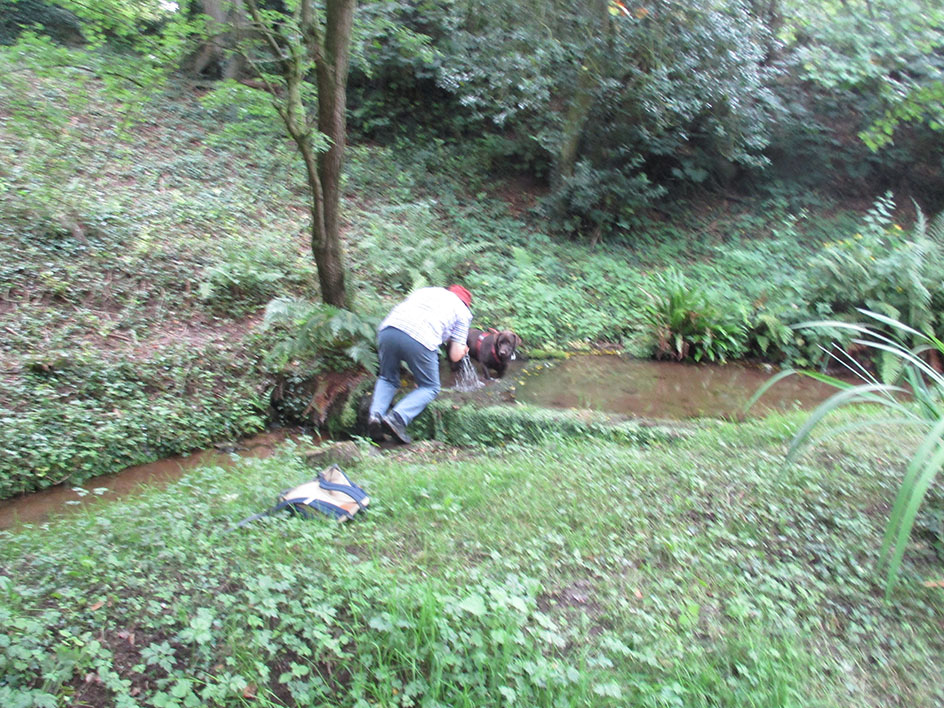As a deliberate policy of the early Christian Church, Interpretatio Christiana, shrines and churches were placed at pagan sacred sites in order to encourage conversion 'by association'. The spring at the bottom of the slope beneath Hentland Church would seem to be a strong candidate to be considered a feature of this type.
In the 11th century the Church at Hentland was dedicated to both St Dyfrig and St Teilo. St Teilo is frequently associated with springs. There was a spring at a church dedicated to St Teilo at Brechfa, Carmarthenshire; and St Teilo's Well at Llangolman, Pembrokeshire, is a series of pools fed by a spring. St Teilo's Well at Llandyfan was also a place of pilgrimage, and the spring water at the well had a reputation for curing various ailments. The well was used in the 19th century for outdoor baptisms, and is still there next to the Victorian church built on the site. There is an ancient well called St Teilo's Well sited on a spring line at the edge of the ridge of land above Llandaff Cathedral.

The Hentland Spring
Historically Hentland is Welsh, lying within the ancient Kingdom of Erging. To the English the area was 'Ergyngafeld' - Archenfield
The Book of Llandaff records that Tempore etguardi regis anglie et grifudi regis gualie -'in the time of Edward, King of England and Gryffyd, King of Wales', Bishop Herewald of Llandaff ordained 'Enniaun filium [son of] Cincenn' to 'hennlann dibric & lannteliau in uno cimiterio'
'Edward, King of England' is Edward the Confessor who died in January 1066 and 'Gryffyd, King of Wales', is Gruffydd ap Llywelyn, who could probably only be referred to as King of Wales from 1057 until his death in 1063
The old church of Dyfrig 'hennlann dibric' and the Church of Teilio 'lannteliau' in one cemetery strongly suggests the merger of two original foundations with seperate dedications
Early churches were often built in pre-existing cemeteries. Sometimes such cemeteries are pre-Christian.
The other dedicatee of the 11th century church, St Teilo, was a pupil of Dyfrig's who himelf rose to prominance in the British Church. In 549 Teilo, with a small group of monks, moved to Dol in Brittany. Teilo's skull was placed in a reliquary in the south chapel of Llandaff Cathedral. Relics are widely distributed, and are venerated at Landeleau (Finistère), Plogonnec (Finistère), and Saint-Thélo (Côtes-du-Nord).
Domesday records that the king has three churches in Archenfield. These are not precisely identified but they were probably Hentland, Llangaran and St Weonard's. Charters from the reign of John onward record grants of the vicarage of Lugwardine 'with the churches or chapels in Erchinfield'. In 1204 John granted the vicarage of Luguardin to Alard together with the chapel of Urchenefeld. Also in John's reign, Joscelin de Welles was appointed to the churches of Urchenefeld and Lugwardin on the resignation of Master Stephen. Henry III granted to John Maunsell junior the churches of Lugwardin and Urchinfield in 1246.
Queen Elizabeth I granted 'our right to the presentation of lugwardyn in the same county of Hereford and all our chapels of langarren, henthlann and sci winards annexed to the same church or dependent upon it'.
As Vicar of Lugwardine in 1430 Richard of Rotherham would have been responsible for the maintenace of the chancel at Hentland - the normal division was that the parishioners maintained the nave, and the church (here in the person of the Vicar) maintained the chancel.
Hentland church was still attached to the Vicarage of Lugwardine in the 19th century and the Vicar of Lugwardine was patron to the Hentland living.
The churchyard appears to have been first enclosed in 1613 when a fence was built around it. The full extent of the original cemetery in which 'hennlann dibric and lannteliau' were consecrated is not known, but graves were observed outside the present churchyard during archaeological excavations in 1970.